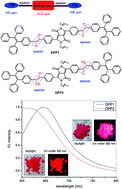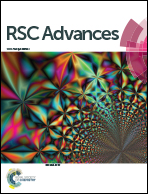Tetraphenylethene-functionalized diketopyrrolopyrrole solid state emissive molecules: enhanced emission in the solid state and as a fluorescent probe for cyanide detection†
Abstract
Two conjugates of tetraphenylethene (TPE) and diketopyrrolopyrrole (DPP) were synthesized and their fluorescence properties were investigated. Both DPP1 and DPP2 show intense fluorescence and large Stokes shifts in both solution and solid state. In dilute THF, DPP1 and DPP2 show emission peaks at 606 nm and 632 nm with a Φf value of 32% and 11%, respectively. However, the powder samples for DPP1 and DPP2 emit at 650 nm and 615 nm with a Φf value of 13% and 7%, respectively. Moreover, DPP2 shows remarkable selectivity and specificity toward CN− over other anions. The color changed from pink to colorless when CN− was added to DPP2 in THF. The maximum emission intensity at 632 nm is quenched 94.6%, which constitutes the fluorescence signature for cyanide detection. The detection limit is 0.3 μM using the fluorescence spectra changes, which is far lower than the WHO guideline of 1.9 μM.


 Please wait while we load your content...
Please wait while we load your content...